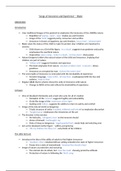‘Songs of Innocence and Experience’ – Blake
INNOCENCE
Introduction
Uses traditional images of the pastoral to emphasise the innocence of the childlike nature
Repetition of ‘piping’, ‘piper’, ‘pipe’ implies joy and freedom
Image of the ‘lamb’ suggests purity, innocence and sacrifice
Innocence is shown as happiness, joy and freedom, ‘joy to hear’, ‘pleasant glee’
Blake raises the status of the child to make his protest clear (children are important to
society)
Child shown as a Christ-like figure, ‘on a cloud’, suggests true goodness and purity,
emphasises the sacrificial nature
Imperatives ‘pipe a song’, ‘write in a book’, ‘sit thee down’ show power
Natural imagery furthers the natural nature of the child and innocence, implying that
children are part of nature
‘Valleys wild’ suggests freedom and openness
The book originates from nature, ‘plucked a hollow reed’, ‘rural pen’, shows
goodness
Innocence as corrupted by man, ‘stained the water clear’
The universality of innocence is contrasted with the inevitability of experience
Inclusive language, ‘every child’, ‘all may hear’, is juxtaposed with the loss and
sadness, ‘wept to hear’
Regular ABAB rhyme scheme shows the unity of innocence with nature
Change to ABCB at the end reflects the inevitability of experience
A Dream
View of idealised Christianity and a God who cares for all of creation
Metaphor of the ‘emmet’ suggests fragility and vulnerability
Christ-like image of the ‘watchman of the night’
Guiding verb ‘follow’, suggests the ability to return to safety and comfort
Image of the natural world as dangerous
Triadic structure of verbs ‘troubled, wildered and forlorn’ to emphasise discomfort
‘Tangled spray’ emphasises the minuteness of the ant
The dreamer is the narrator
He feels pity, ‘I dropped a tear’ as the innocent should
Vision of himself, ‘methought I lay’
State of sleep as dangerous, ‘angel-guarded bed’, needs help and watching over
Ant as the idealised mother figure – selfless and grieving
‘Oh my children! Do they cry?’, only thinks of her children
The Little Girl Lost
Introduces the idea of the ability of adults to find higher innocence
‘Southern clime’, idealised African setting embodies the state of higher innocence
Passes into a state of womanhood, ‘loosened her slender dress’
Image of nature as protective and nurturing
The animals do not attack, but ‘view the maid’, showing protective attitude
Protection of nature in following the ‘bird’s song’




